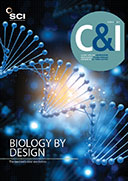Bridges, planes and ships are all liable to weaken and degrade over time. But green laser light could detect structural damage far earlier than other non-destructive testing (NDT) methods that don’t require removing samples and taking them back to the lab, according to researchers speaking at the ACS meeting in San Francisco in April. It could warn of danger sooner.
‘Techniques such as X-ray imaging or using magnetic particles only say if a material is likely to fail right before it fails,’ said Scott Smith, an undergraduate student working on the project at Brigham Young University in Utah. ‘With [our new method] preliminary tests have shown that we can see damage far before this, when microscope fractures form [and] we can detect even small or reversible stresses at the material surface.’
The technique relies on a spectroscopic phenomenon called second harmonic generation (SHG), he explained, whereby the wavelength of light is altered on impinging on another material. When green laser light is shone onto a metal sample, for example, some of the light is converted to UV light that bounces back from the surface and is detected by a sensitive detector.
Current commercial techniques of non-destructing testing (NDT) methods, such as X-ray imaging, detect microscopic cracks in metals after they have formed. But they are unable to detect the small-scale plastic deformations that cause them, elaborated Alex Farnsworth, another student researcher on the project. These plastic deformations are caused by an accumulation of internal irregularities within a material’s lattice, known as dislocations, which show up as minute ‘intrusions and extrusions’ at the material surface that can be detected by SHG.
An SHG signal takes only nanoseconds to generate, Farnsworth pointed out, and can be done with relatively inexpensive commercial lasers that could potentially be adapted as a hand held damage scanner.
The researchers, in the group of James Patterson, are exploring applications in the aerospace sector, and with the US Navy. Currently, large numbers of aerospace components are routinely scrapped after a certain amount of use to avoid catastrophic failure; this replacement schedule is based on the average performance of multiple tested component, not the actual condition of the component itself. SHG could check if it really is worn out or still has useful life.
In the US Navy, the aluminium/magnesium alloy used aboard ships and other vessels gradually assumes a ‘new beta phase aluminium’ composition, which is more susceptible to corrosion, on becoming stressed. The group’s initial results show this beta phase alloy can be detected by SHG.
‘Our research has shown SHG is sensitive to plastic deformation, and suggests that SHG signal may be a viable method of NDT,’ the researchers reported. ‘SHG’s sensitivity to plastic deformation is currently unprecedented in the field of NDT, and SHG may provide a means to detect weaknesses in materials far earlier than any other NDT method currently available today.’
However, one limitation of the technology is that the technique is heavily dependent on the finish at the material surface, they acknowledged.




